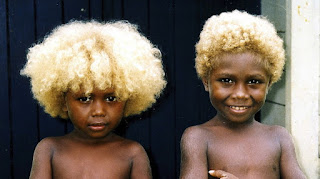Origin: Solomon Islands (Malaita)
The story
 |
| Image from Rejected Princesses |
Meanwhile, the husbands of the kidnapped women gather a large amount of bounty for anyone who can rescue their wives. Men set out with a hundred canoes for the rescue, but when the gosile swoop down and eat two of them, they hastily retreat. Soon after, another volunteer appears: Riina, the blonde warrior woman with her group of Amazons from the island of Lumalao. Initially no one thinks they could possibly succeed where men failed, but Riina states that she can easily break the jaw of any gosile, even if it's a male one.
The Amazons set out in their canoe to the ghosts' island. The two gosile attack them on the way, but Riina wrestles one of them into submission, ties him up, and interrogates him about where his powers are hidden. When she finds the magic objects, she steps over the, desecrating them with her "female presence", rendering the gosile powerless. She then befriends him and tricks him into helping her get to the house on the rock. Entering the house she sits in places where a woman is not allowed to sit, angering the two gosile who attack her. Riina kills both of them with her boomerang, and rescues the women. They all return home, and the Amazons get all the bounty.
What makes it a feminist story?
Not only do we have strong, independent woman warriors in this story (who work as a team), but also, they actually win in this story. On a global scale it is hard to find Amazon legends that don't end with the Amazons being defeated, disappearing, or marrying and settling down. Riina and her Amazons succeed where men have failed, and they get appreciation and a reward for it. The latter they take as a team, although Riina asks for an extra gift for herself, and receives a household spirit.
I find it especially interesting that Riina overcomes her enemies by breaking taboos. She takes the first gosile's power by stepping over the magic items that contain it (it is a taboo for women to step over things in various cultures), and she angers the second one by sitting in places where women are not allowed to sit. Riina knows the rules limiting her femininity, and breaks them on purpose to gain an advantage. (This reminds me of the time in first grade when I found out that the boys who bullied me were afraid of cooties. Soon my parents were called in because I was "throwing kisses at the boys" to keep them away. Dunno, I think it was a pretty solid defense mechanism.)
From another story we find out more about the warrior women of Lumalao. We encounter Moaanawalo, Riina's sister and the leader of the tribe. We find out that the "light skinned" warrior women live in a type of house that is usually reserved for men. They form a real society: they hunt, they fish, and they take their wares to market. They make alliances and launch revenge campaigns if they are attacked. At one point Moaanawalo dresses up as a married woman (taboo for unmarried women) to make a plan succeed.
Things to consider
The texts collected by Kay Bauman carry a lot of symbolism and cultural references. The book contains a short introduction for both stories, highlighting some of the exciting elements, but European readers might see these as simpler stories than they really are. It's worth digging deeper into the traditions of Malaita, to understand Riina's legends better.
Sources
Kay Bauman: Solomon Island folktales from Malaita (Rutledge, 1998.)
Bo Flood, Beret E. Strong, William Flood: Pacific Island Legends (Bess Press, 1999.)
Riina appeared in the Rejected Princesses series.
Notes
It actually happens on the Solomon Islands that dark-skinned Melanesian people are born with natural blonde hair.
 |
| Image from here |









Certainly this story contains the lesson that women can be strong... but to me it also contains the lesson that these sorts of taboos are stupid! (I don't doubt that plenty of my culture's taboos are stupid, too. Maybe someday humans will learn to stop trying to limit each other arbitrarily.)
ReplyDelete